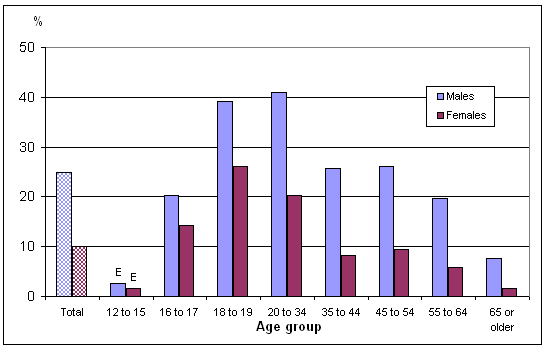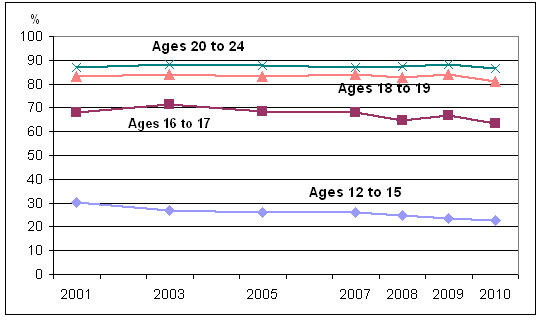Heavy drinking, 2010
Archived Content
Information identified as archived is provided for reference, research or recordkeeping purposes. It is not subject to the Government of Canada Web Standards and has not been altered or updated since it was archived. Please "contact us" to request a format other than those available.

Heavy drinking refers to having consumed five or more drinks, per occasion, at least once a month during the past year. This level of alcohol consumption can have serious health and social consequences, especially when combined with other behaviours such as driving while intoxicated.
In 2010, 24.8% of males and 10.1% of females reported heavy drinking. A higher proportion of males than females reported heavy drinking in every age group, except in the group aged 12 to 15 where there was no significant difference between the sexes. Males aged 18 to 19 (39.2%) and 20 to 34 (41.1%) were the most likely to report heavy drinking, and females aged 18 to 19 (26.1%) and 20 to 34 (20.2%) were more likely to report heavy drinking than females in all other age groups (Chart 1).
Chart 1
Percentage who consumed 5 or more drinks per occasion at least 12 times a year, by age group and sex, household population aged 12 or older, Canada, 2010

E Use with caution (coefficient of variation 16.6% to 33.3%).
Source: Canadian Community Health Survey, 2010.
The proportion of residents reporting heavy drinking was lower than the national average of 17.3% only in Ontario (16.1%) and British Columbia (15.7%). Residents of Newfoundland and Labrador (23.8%), Nova Scotia (20.2%), New Brunswick (20.6%), Alberta (19.5%), Yukon (26.3%) and Northwest Territories (35.5%) reported heavy drinking rates above the national average.
From 2009 to 2010, there was no significant change in the percentage of 12- to 15-year-olds who had at least one alcoholic drink in the past year, though from 2001 to 2010 this percentage declined from 30.2% to 22.7% (Chart 2).
The percentage of 16- to 17-year olds who had at least one alcoholic drink in the past year declined from 68.2% in 2001 to 63.5% in 2010, though there was no significant change from 2009 to 2010.
The percentage who had at least one alcoholic drink in the past year remained steady between 2001 and 2010 in the age groups between 18 and 24 years (Chart 2).
Chart 2
Percentage who had at least one alcoholic drink in the past year, by age group, household population aged 12 or older, Canada, 2001 to 2010

Source: Canadian Community Health Survey, 2001, 2003, 2005, 2007, 2008, 2009, 2010.
References
Hotton, Tina and Dave Haans. 2004. "Alcohol and drug use in early adolescence." Health Reports. Vol. 15, no. 3. May. Statistics Canada Catalogue no. 82-003. pages. 9–19. /studies-etudes/82-003/archive/2004/6846-eng.pdf (accessed May 10, 2010).
Pérez, Claudio. 2005. "Passengers of intoxicated drivers." Health Reports. Vol. 16, no. 2. March. Statistics Canada Catalogue no. 82-003. pages. 35–37. /studies-etudes/82-003/archive/2005/7788-eng.pdf (accessed May 10, 2010).
Tjepkema, Michael. 2004. "Alcohol and illicit drug dependence." Health Reports. Vol. 15 (Supplement). Statistics Canada Catalogue no. 82-003. pages. 9–19. /pub/82-003-s/2004000/pdf/7447-eng.pdf (accessed May 10, 2010).
Wilkins, Kathryn. 2002. "Moderate alcohol consumption and heart disease." Health Reports. Vol. 14, no. 1. October. Statistics Canada Catalogue no. 82-003. pages. 9–24. /studies-etudes/82-003/archive/2002/6342-eng.pdf (accessed May 10, 2010).
Data
Additional data from the Canadian Community Health Survey are available from CANSIM table 105–0501 and summary tables Heavy drinking, by age group and sex and Heavy drinking, by sex, provinces and territories.
- Date modified:
